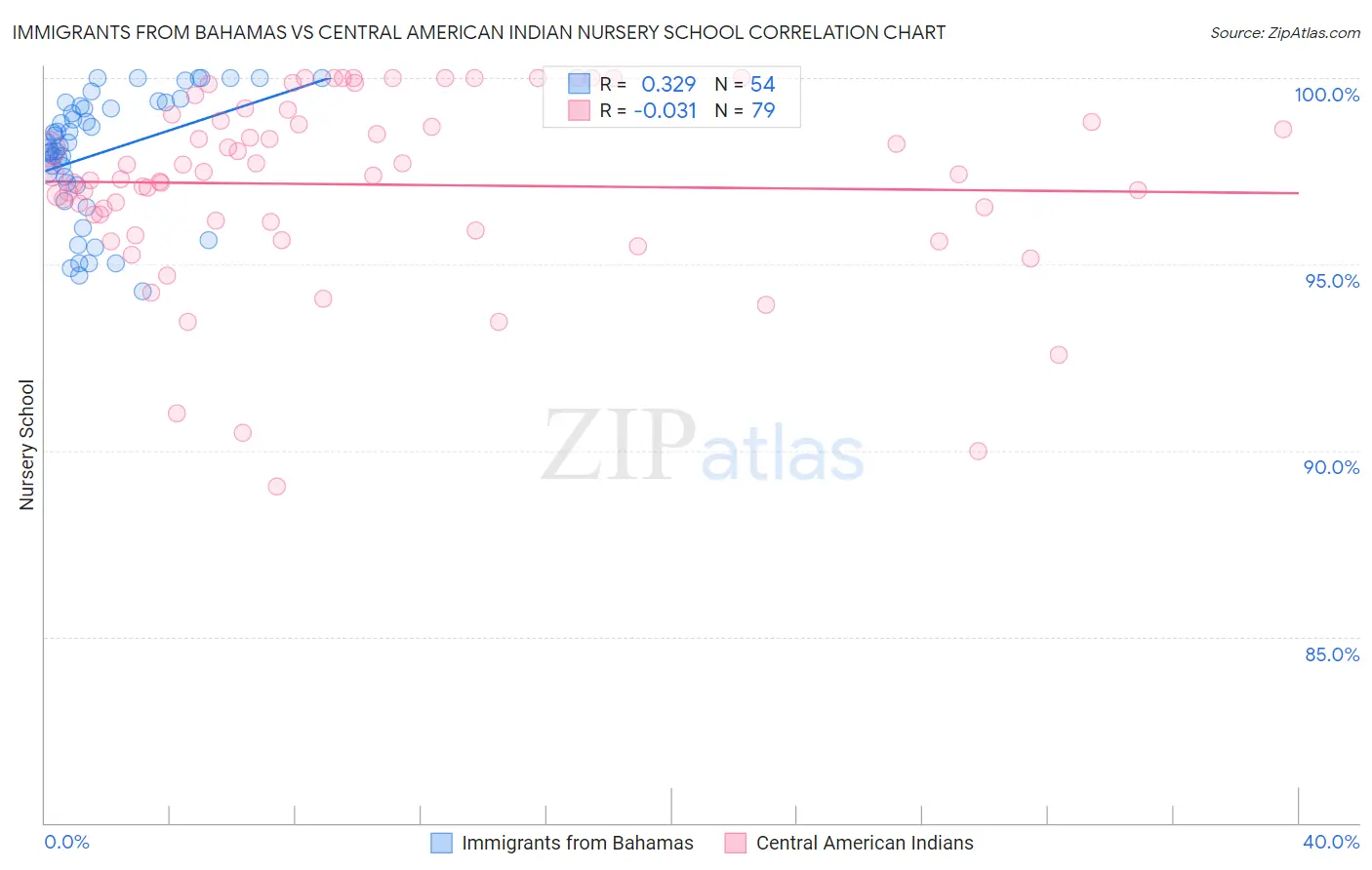Immigrants from Bahamas vs Central American Indian Nursery School
COMPARE
Immigrants from Bahamas
Central American Indian
Nursery School
Nursery School Comparison
Immigrants from Bahamas
Central American Indians
97.8%
NURSERY SCHOOL
8.6/ 100
METRIC RATING
212th/ 347
METRIC RANK
97.2%
NURSERY SCHOOL
0.0/ 100
METRIC RATING
298th/ 347
METRIC RANK
Immigrants from Bahamas vs Central American Indian Nursery School Correlation Chart
The statistical analysis conducted on geographies consisting of 104,666,627 people shows a mild positive correlation between the proportion of Immigrants from Bahamas and percentage of population with at least nursery school education in the United States with a correlation coefficient (R) of 0.329 and weighted average of 97.8%. Similarly, the statistical analysis conducted on geographies consisting of 326,141,567 people shows no correlation between the proportion of Central American Indians and percentage of population with at least nursery school education in the United States with a correlation coefficient (R) of -0.031 and weighted average of 97.2%, a difference of 0.64%.

Nursery School Correlation Summary
| Measurement | Immigrants from Bahamas | Central American Indian |
| Minimum | 94.3% | 89.0% |
| Maximum | 100.0% | 100.0% |
| Range | 5.7% | 11.0% |
| Mean | 98.0% | 97.1% |
| Median | 98.2% | 97.4% |
| Interquartile 25% (IQ1) | 97.2% | 96.2% |
| Interquartile 75% (IQ3) | 99.2% | 98.9% |
| Interquartile Range (IQR) | 2.1% | 2.7% |
| Standard Deviation (Sample) | 1.6% | 2.5% |
| Standard Deviation (Population) | 1.6% | 2.4% |
Similar Demographics by Nursery School
Demographics Similar to Immigrants from Bahamas by Nursery School
In terms of nursery school, the demographic groups most similar to Immigrants from Bahamas are Moroccan (97.8%, a difference of 0.0%), Immigrants from Oceania (97.8%, a difference of 0.010%), Laotian (97.8%, a difference of 0.010%), South American Indian (97.8%, a difference of 0.010%), and Bahamian (97.8%, a difference of 0.010%).
| Demographics | Rating | Rank | Nursery School |
| Immigrants | Chile | 17.3 /100 | #205 | Poor 97.9% |
| Immigrants | Albania | 16.4 /100 | #206 | Poor 97.9% |
| Africans | 15.4 /100 | #207 | Poor 97.9% |
| Immigrants | Northern Africa | 11.7 /100 | #208 | Poor 97.8% |
| Costa Ricans | 11.3 /100 | #209 | Poor 97.8% |
| Immigrants | Oceania | 10.2 /100 | #210 | Poor 97.8% |
| Laotians | 9.8 /100 | #211 | Tragic 97.8% |
| Immigrants | Bahamas | 8.6 /100 | #212 | Tragic 97.8% |
| Moroccans | 8.3 /100 | #213 | Tragic 97.8% |
| South American Indians | 8.0 /100 | #214 | Tragic 97.8% |
| Bahamians | 7.4 /100 | #215 | Tragic 97.8% |
| Uruguayans | 7.1 /100 | #216 | Tragic 97.8% |
| Samoans | 6.3 /100 | #217 | Tragic 97.8% |
| Immigrants | Panama | 5.3 /100 | #218 | Tragic 97.8% |
| Immigrants | Morocco | 5.1 /100 | #219 | Tragic 97.8% |
Demographics Similar to Central American Indians by Nursery School
In terms of nursery school, the demographic groups most similar to Central American Indians are Immigrants from Cuba (97.2%, a difference of 0.010%), Immigrants from Dominica (97.2%, a difference of 0.010%), Haitian (97.2%, a difference of 0.020%), Immigrants from Eritrea (97.2%, a difference of 0.050%), and Immigrants from South Eastern Asia (97.1%, a difference of 0.050%).
| Demographics | Rating | Rank | Nursery School |
| British West Indians | 0.0 /100 | #291 | Tragic 97.3% |
| Houma | 0.0 /100 | #292 | Tragic 97.3% |
| Malaysians | 0.0 /100 | #293 | Tragic 97.3% |
| Immigrants | Grenada | 0.0 /100 | #294 | Tragic 97.3% |
| Immigrants | Immigrants | 0.0 /100 | #295 | Tragic 97.2% |
| Immigrants | Eritrea | 0.0 /100 | #296 | Tragic 97.2% |
| Immigrants | Cuba | 0.0 /100 | #297 | Tragic 97.2% |
| Central American Indians | 0.0 /100 | #298 | Tragic 97.2% |
| Immigrants | Dominica | 0.0 /100 | #299 | Tragic 97.2% |
| Haitians | 0.0 /100 | #300 | Tragic 97.2% |
| Immigrants | South Eastern Asia | 0.0 /100 | #301 | Tragic 97.1% |
| Immigrants | Caribbean | 0.0 /100 | #302 | Tragic 97.1% |
| Nicaraguans | 0.0 /100 | #303 | Tragic 97.1% |
| Ecuadorians | 0.0 /100 | #304 | Tragic 97.1% |
| Somalis | 0.0 /100 | #305 | Tragic 97.1% |